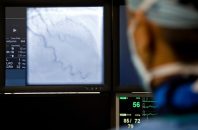Courtesy of SBHCI. Angioplasty in patients with chronic stable angina and functionally significant lesions improves clinical outcomes and quality of life over the long term, as compared with optimal medical therapy alone. Furthermore, the invasive approach becomes more cost-effective as the years go by. Previously, FAME 2 had shown that angioplasty was initially more expensive, but…
TCT 2017 | ORBITA: The Placebo Effect of Angioplasty
Courtesy of the SBHCI. Chronic stable angina and severe coronary lesion patients who undergo angioplasty in a single vessel show no better outcomes than individuals who undergo a placebo sham procedure when it comes to exercise capacity and symptoms, according to this study presented at TCT and published simultaneously in the Lancet. The curious results…
HREVS: Hybrid Revascularization Offers No Advantage in Multivessel Disease
Courtesy of SBHCI. Hybrid revascularization, which combines CABG with PCI, failed to reduce myocardial ischemia and major cardiac and cerebrovascular events, compared to cardiac artery bypass graft or PCI separately. However, this small study does not provide conclusive evidence, which calls for further randomized studies with enough statistical power to answer this question. Fortunately, we won’t have…
Fentanyl in Angioplasty: What Is the Price of More Comfort During the Procedure?
Fentanyl is a potent opiate commonly administered in the cath lab. Recently, questions on its safety have been raised by research demonstrating that intravenous morphine significantly delays the absorption of oral P2Y12 platelet inhibitors. The mechanism might be slowed gastric emptying. The Platelet Aggregation with tiCagrelor Inhibition and FentanYl (PACIFY) trial enrolled 212 patients undergoing indicated…
Frequency and Evolution of Cardiac Perforation in Patients with a History of MRS
Courtesy of Dr. Carlos Fava. Coronary perforation (CP) is a very uncommon event (≈0.4%), associated with severe complications that entail risk of death. It has usually been related to patients with a history of myocardial revascularization surgery (MRS). However, this group usually presents lower rates of cardiac tamponade due to pericardial fibrosis caused by surgery. This…
Diabetics’ Silent Ischemia Myth Busted
Diabetes mellitus patients generally present more diffuse coronary disease, faster lesion progression and higher risk of restenosis after PCI. The way these anatomical differences translate into in a different clinical practice, compared to non-diabetic patients, remains unclear. Prior studies comparing the frequency of angina symptoms in diabetic vs. non-diabetic patients have arrived to contradicting outcomes,…
Introducing the number one enemy of PCI: diabetes
About 25% of patients with multivessel disease undergoing myocardial revascularization surgery or PCI have diabetes. In this subgroup, the benefit of surgery in terms of mortality has long been shown: in the BARI study (Bypass Angioplasty Revascularization Investigation) patients undergoing PCI had close to double the mortality rate at 5 years compared to those…
Additional Benefit from Radial Artery Graft in Myocardial Revascularization Surgery
Used to different extents according to institution, surgeon, and historical time, the radial artery graft is yet to prove whether it can improve the outcomes of myocardial revascularization surgery when added to a single or bilateral internal thoracic artery graft. The ART (Arterial Revascularization Trial) was designed to compare survival after bilateral vs. single left internal…
Is Same-Day Discharge After Angioplasty Safe?
Overnight observation after coronary angioplasty has been the standard of care in the United States. The foundations for this practice go back to the early days of balloon angioplasty, when acute occlusion and access-site complications were frequent. There are several registries and randomized studies showing the clear safety of same-day discharge after coronary angioplasty. This practice…
SYNTAX II: Better Stents, IVUS, FFR, or a Combination of All of Them to Catch Up with Surgery
In patients with 3-vessel disease, surgery obtained better outcomes than angioplasty, according to results from the SYNTAX and FREEDOM trials, which used first-generation drug-eluting stents. Even in the BEST trial, which used new-generation stents, surgery still offered far better outcomes. Nobody is surprised by the fact that, whenever angioplasty evolves due to a new device…
“Ad Hoc” PCI during TAVR: No Impact on Safety or Long Term Outcomes
According to a recent study published in Circulation Cardiovascular Interventions, screening for coronary artery disease (CAD) with an invasive coronary angiography (as part of the protocol prior TAVR) and performing PCI and TAVR in the same session, has no impact on periprocedural safety or on long term outcomes. Study outcomes offer new hope, especially as regards using TAVR…










